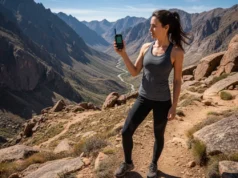In this article
You’re four days into a week-long backpacking trip, miles from the nearest town. Your phone, your primary navigation and lifeline, is at 5%. You’ve had your backpacking solar panel strapped to your backpack all day, but intermittent cloud cover and dense trees have rendered its “28W” wattage rating meaningless, a common issue with many solar chargers. This common trailside frustration highlights a critical truth: a solar panel’s value isn’t on its spec sheet, but in its ability to deliver reliable solar power in the imperfect real trail conditions. This guide moves beyond wattage and weight to provide an expert framework for choosing a portable solar charger that truly performs when you need it most, addressing the key question: are solar panels worth it for backpacking? You will learn why “Real-World Efficiency” in varied sun is the single most important solar charger performance metric, often yielding only 50-60% of a panel’s rated wattage. You’ll discover the “Portability Index,” a crucial calculation of power-per-ounce that reveals a panel’s true weight efficiency. We will also help you understand non-negotiable features for serious use, such as durable ETFE lamination, high IP weather-resistance ratings, and critical auto-restart technology. Finally, you will find our top-rated solar panels for 2025, curated and field-tested for three distinct hiker personas: The Thru-Hiker, The Weekend Warrior, and The Ultralight Purist.
How to Choose the Right Backpacking Solar Panel: An Expert’s Framework
This section is designed to arm you with the objective knowledge needed to make a smart, confident choice, moving beyond superficial specs to a deep understanding of on-trail performance and compatibility with devices like your GPS devices, headlamp, or even a camera.
Why is Real-World Efficiency More Important Than Rated Watts?
The large wattage number printed on a solar panel’s box is often the most misleading metric in outdoor gear. That number is determined under Standard Test Conditions (STC), which means a lab environment with 1,000 W/m² of sunlight at a cool 25°C—the definition of perfect direct sun. In reality, a host of variables conspire to reduce that theoretical power output. The angle of the sun, passing clouds, atmospheric haze, partial shading from a single tree branch, and even high temperatures all significantly diminish a panel’s performance. The hard truth is that a panel’s actual power output, especially its cloudy day performance, is often only 50-60% of its rated wattage. This is a critical finding from our solar testing. For this reason, the most reliable metric for performance is tested energy generation, measured in milliamp-hours (mAh) over a set period. This reflects the actual energy generated in direct sun versus the energy generated in indirect sun, giving you a true picture of its on-trail capability.
Now that we understand real power output, let’s see how that output compares to the weight you have to carry. This link connects our discussion of a panel’s true performance to the foundational concept of building a cohesive thru-hiking gear list where every component must justify its weight and function.
What is the Portability Index and Why Does It Beat a Simple Weight Comparison?
In the world of ultralight hiking, the quest for the lightest solar panel for backpacking isn’t always the smartest move. This is especially true for functional solar panels. A 5-watt panel might weigh only a few ounces (oz), but if it produces negligible energy, it’s just dead weight in your pack. To cut through this, we use a metric called the Portability Index, which is a measure of power density. It’s calculated by dividing the panel’s real-world power output (in mAh/hr) by its weight in ounces. This simple calculation answers the single most critical question for a backpacker seeking a weight efficient power source: “Which panel provides the most energy for the weight I have to carry?” This metric is the great equalizer, making it easy to identify which solar charging option is truly the most efficient. For ultralight and long-distance hikers who scrutinize every gram, understanding the Portability Index is non-negotiable; it’s the key to maximizing your solar power generation while minimizing your burden, a core tenet of the philosophy of lightweight backpacking.
A panel can be light and powerful, but if it breaks on the first trip, its value is zero.
How Do Materials and IP Ratings Determine a Panel’s Durability?
A backpacking solar panel’s durability and ruggedness are paramount; it must withstand significant abuse. It will be scraped by branches, bumped against rocks, and exposed to relentless rain and dust. A panel’s weather resistance starts with its materials. Pay close attention to the surface lamination. Cheaper panels often use Polyethylene terephthalate (PET), which is prone to scratching, delamination, and degradation under UV light. Higher-quality panels use Ethylene tetrafluoroethylene (ETFE), a far superior material that is more durable, UV-resistant, longer-lasting, and has better light transmittance.
Beyond the panel surface, you need to know its resistance to the elements, which is defined by its Ingress Protection (IP) rating. This two-digit number tells you how well it’s sealed. The first digit is for solids (dust), and the second is for liquids (water). A rating of IP65 means the panel is completely dust-tight and can resist water jets, making it perfectly suitable for heavy rain. An IP rating of IP67 waterproof or IP68 indicates it can even survive temporary immersion in water. This concept is just as important for your electronics as it is for your outerwear, and understanding waterproof ratings is a foundational piece of technical knowledge for any serious hiker.
Beyond being tough, a panel’s design must be practical for daily use on the trail.
What On-Trail Usability Features are Non-Negotiable?
A panel’s design dictates its practicality and efficiency in the field. Small convenience features can make a huge difference, like a built-in sundial or kickstands that allow for optimal sun angle when you’re at the campsite, or reinforced grommets that let you securely strap to backpack. Modern output ports, especially a USB-C outlet with Power Delivery (PD3.0 Type C) and at least one USB-A outlet for legacy cables, define a panel’s versatility for charging multiple devices.
Pro-Tip: When lashing a panel to your pack, use mini-carabiners to attach it to compression straps or gear loops. This allows the panel to “float” slightly, maximizing its exposure to the sun as you move and preventing it from being damaged by the pack’s contents.
However, one feature stands above all others as a critical, non-negotiable necessity: Auto-Restart Technology. Cheaper panels have a fatal flaw. When a cloud passes overhead or you walk into a shaded section of trail, the direct solar charging connection to your device is interrupted. Without auto-restart, the panel will not resume charging once you’re back in the sun. You have to manually unplug and replug your device every single time, which is maddeningly impractical on the trail. A panel with auto-restart technology automatically re-establishes the charging connection, ensuring you capture every available ray of sun without a second thought. For more expert advice on field charging, REI provides a solid overview of solar chargers and portable power.
With a clear understanding of what makes a great panel, let’s look at how we applied this framework to find the best options on the solar market.
Our Selection Process: How We Built This Guide
To build absolute trust, we want to be transparent about our rigorous research and curation process. This guide is built on a foundation of independent testing data from our solar testing team, lab/field solar chargers test results, expert analysis, and real-world user feedback, not manufacturer claims. We are committed to objectivity. Every solarpanel considered was systematically scored against the critical attributes defined above: Real-World Efficiency, Portability Index, Durability, Usability, setup ease, charging speed, and Overall Value. We began with a wide market survey and narrowed the field to top contenders based on performance data and panel side-by-side comparisons. We then curated the final recommendations to solve the specific problems of our core hiker personas. If you purchase through links in this article, we may earn a small commission at no extra cost to you. This helps support our independent research and testing. We only recommend gear we believe in.
The Best Backpacking Solar Panels of 2025: Our Top Recommendations for Every Need
Here we present the curated top recommendations for the key user personas, empowering you to make your final, confident decision for your next backpacking trip.
Our Top Picks for The Thru-Hiker / Long-Distance Trekker
This user demands the ultimate balance of reliable power in varied conditions, reasonable weight, and trail-tested durability for months of hiking daily. A thru-hiker needs a solar charging system that can consistently recharge a battery pack like the popular Nitecore NB10000 after a long day on the trail.
Pro-Tip: For long-distance trips, always pair your solar panel with a power bank. Charge the power bank during the day while you hike, then charge your devices from the stable power of the bank at night. This protects your electronics’ batteries from the fluctuating voltage of direct solar charging.
Our Top Picks for The Tech-Equipped Weekend Warrior
This hiker is on shorter trips and can tolerate more weight in exchange for high power output and convenience features to keep a wide array of camping gear charged, from pocket-sized flashlights and phones to GoPro cameras.
Our Top Picks for The Ultralight Purist
This user demands the absolute lowest weight (oz) and highest power density (Portability Index), and is willing to accept compromises in features, total power, and even durability to save grams.
Conclusion
The best measure of a solar panel is its tested real-world power output in mAh/hr, not its advertised wattage. True efficiency is best understood through the Portability Index (power per ounce), which helps you carry the most energy for the least weight. For serious backpacking, look for durable ETFE construction, a high IP rating (like IP67 waterproof), and the non-negotiable auto-restart technology. The right panel is a strategic choice based on your hiker persona—balancing the thru-hiker’s need for reliability on a long backpacking trip, the weekend warrior’s demand for a portable powerhouse, and the purist’s obsession with weight. Choose the panel that best fits your hiking style from our recommendations and share your on-trail charging experiences in the comments below to help fellow hikers.
Frequently Asked Questions about Backpacking Solar Panels
Should I charge my phone directly from a solar panel? How to charge phone while backpacking is a common question.
It is strongly recommended not to charge directly; instead, you should charge a power bank first and then charge your devices from the power bank. Most hiking electronics require a steady, stable current that portable solar panels simply cannot provide in variable sun. Using a battery pack or an integrated battery bank as a buffer ensures a safe, consistent charge that protects your device’s battery health. The BioLite SolarPanel 10+ is a unique exception to this rule, as its integrated battery performs this buffering function automatically.
What is auto-restart technology and why is it so important?
Auto-restart is a critical feature that allows a solar panel to automatically resume charging after it has been temporarily interrupted by a cloud or shade. Panels without this feature, like the inexpensive Lixada 10W, will stop charging and will not start again until you manually unplug and replug your device. This makes them extremely frustrating and impractical to use on the trail where conditions are constantly changing.
Is a higher “Watt” rating always better?
No, the wattage rating is a theoretical maximum measured in a perfect lab setting and is not a guarantee of on-trail performance; many factors determine if solar chargers work on cloudy days. Real-world variables like sun angle, clouds, and heat drastically reduce output. A highly efficient 20-watt panel like the Anker 21W PowerPort Solar can sometimes outperform a poorly made 28-watt panel in real-world conditions. You should always focus on tested mAh output instead of the advertised wattage.
What does a solar panel’s IP rating (like IP67) mean?
The IP rating (Ingress Protection) measures a device’s weather resistance to dust and water. The first digit rates solid protection, where a ‘6’ indicates it is completely dust-tight. The second digit rates liquid protection; a ‘5’ resists water jets (rain), while a ‘7’ allows for temporary immersion in water. Therefore, a panel with an IP67 rating like the FlexSolar E10 Mini is fully protected from dust and can survive being dropped in water, making it extremely durable for trail use.
Risk Disclaimer: Hiking, trekking, backpacking, and all related outdoor activities involve inherent risks which may result in serious injury, illness, or death. The information provided on The Hiking Tribe is for educational and informational purposes only. While we strive for accuracy, information on trails, gear, techniques, and safety is not a substitute for your own best judgment and thorough preparation. Trail conditions, weather, and other environmental factors change rapidly and may differ from what is described on this site. Always check with official sources like park services for the most current alerts and conditions. Never undertake a hike beyond your abilities and always be prepared for the unexpected. By using this website, you agree that you are solely responsible for your own safety. Any reliance you place on our content is strictly at your own risk, and you assume all liability for your actions and decisions in the outdoors. The Hiking Tribe and its authors will not be held liable for any injury, damage, or loss sustained in connection with the use of the information herein.
Affiliate Disclosure: We are a participant in the Amazon Services LLC Associates Program, an affiliate advertising program designed to provide a means for us to earn advertising fees by advertising and linking to Amazon.com. As an Amazon Associate, we earn from qualifying purchases. We also participate in other affiliate programs and may receive a commission on products purchased through our links, at no extra cost to you. Additional terms are found in the terms of service.





